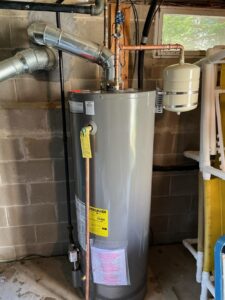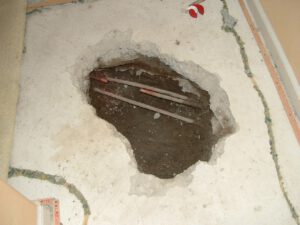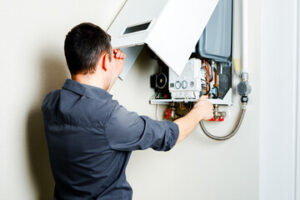Home » Plumbing
Category Archives: Plumbing
Water Heater Replacement – Why You Should Leave it to the Pros
Water Heater Replacement Denver can be a major undertaking. It’s usually best left to the pros.

Rising energy bills, rusty water, slow leaks, and corroded tank liners are good reasons to replace a hot water heater.
Changing the fuel type is another consideration, and can add to project costs. Adding electrical wiring and gas lines requires the services of an electrician and plumber.
The water heater is one of the most important household appliances. It powers everything from hot showers to laundry and dishes. But, when yours is on the fritz, it can be a major disruption to your family’s routine. It can also be a costly one, as you may have to pay for emergency replacement service.
A new water heater is a considerable investment, and there are many factors that can influence its cost. First, you must determine what kind of heater you want to replace yours with. There are several different options, including tank and tankless models, as well as gas or electric. You will also need to decide between power venting and direct venting. Power venting adds around $300-$600 to your total. Direct venting brings combustion air from outside and exhausts it directly outdoors, adding another $500-$1,000 to your price.
There are also extra expenses to consider if you’re changing the location or converting to a different fuel type. These can include carpentry costs, if needed, and additional labor to move piping. You may also have to spend on a new breaker box and gas line, depending on your installation plan.
A professional plumber will be able to give you an accurate estimate for the cost of your new water heater installation. They will be able to help you choose the best style for your home and budget, as well as install it correctly. In addition, a plumber can help you figure out the right size of the heater to fit your needs.
If your water heater is older and more likely to break down, you should invest in a replacement sooner rather than later. A newer model will be more energy efficient and save you money on your utility bills. It will also be able to hold more water and provide faster heating.
You should also factor in the cost of a new expansion tank, which can run from $100 to $350. The tank helps control pressure and prevents overflow. It is necessary for water heater safety and should be replaced every five years. You should also consider investing in a warranty, which can protect you from expensive repairs.
Energy Efficiency
When shopping for a new water heater, pay attention to the energy efficiency rating. This figure, displayed on a sticker on the unit, indicates how much the model costs to operate annually. A higher number means the model is more efficient.
The type of fuel used to power the unit can also affect its energy efficiency. Gas-powered units with sealed combustion and powered venting offer superior efficiency, as these systems separate combustion air from house air. They also have a fan to assist in exhausting the gases, which helps reduce energy consumption.
Upgrading to a heat pump water heater can also save money on utility bills, as these models use less energy than conventional electric ones. However, they may not work well in cold climates where temperatures drop below freezing.
You can reduce energy usage by installing low-flow showerheads and faucet aerators, and reducing hot water consumption when possible. However, the best way to lower your energy bill is by installing a more efficient water heater. A trained Carter professional can help you select the right model for your home and budget.
If your current unit is old and prone to malfunction, consider upgrading it. Newer models are more reliable and offer better energy efficiency. They also come with longer warranties, so you can be sure that the replacement will last. Look for features like anti-scale devices, which reduce the buildup of mineral scale on heating elements, and brass drain valves, which are more durable than plastic ones.
It’s important to have a plumber install your new water heater, as the labor involved is extensive and complex. It’s also essential to choose a contractor with experience with your particular water heater style. For example, if you’re replacing a tankless system, make sure your installer knows how to install that kind of heater correctly.
A plumber can also help you decide where to locate your new water heater. For maximum efficiency, place it in a warm area with easy access to your kitchen and bathrooms. Ideally, it should be located close to the main water line so that you don’t have to travel a long distance for hot water.
Life Expectancy
Nothing lasts forever, and even the most reliable water heaters have a lifespan that eventually comes to an end. Many homeowners don’t realize when their water heaters are reaching the end of their life expectancy, and they can experience a lot of inconvenience if they wait too long to replace their old water heater. However, you can avoid this inconvenience by keeping an eye out for certain warning signs that your water heater is approaching the end of its lifespan.
The first warning sign is when your hot water starts running out quickly. This is caused by mineral deposits that build up in the tank and prevent it from heating up. You can try a few things to fix the problem, but if you’re constantly experiencing this issue it may be time for a new water heater.
Another sign that your water heater is nearing the end of its lifespan is when you start to notice rust on the surface of the tank. This can be a dangerous issue because it means that the metal is starting to corrode, and this can lead to leaks. If you see rust on the surface of your water heater, it’s important to call a plumber right away to have it replaced.
Another sign of a deteriorating water heater is when you start to hear gurgling noises during use. This is a sign that sediment has built up in the tank, and this can cause the water to become rusty. In addition, a large amount of sediment can also decrease the water heater’s efficiency and cause it to consume more energy.
Another sign that your water heater is getting close to the end of its lifespan is when you start seeing puddles on the floor around it. This is a sign that your water heater is leaking, and it can cause damage to your home and your belongings. Leaks can be repaired, but if you see water on the floor of your house, it’s best to get a professional to take a look at your water heater.
Installation
There are many factors that go into the installation process of a new water heater. It’s important to choose a model that is the right size for your household. If you have a smaller home or live alone, a 40-gallon tank may be enough for your needs. If you have a larger household or live with several people, a 50-gallon or 80-gallon tank may be more suitable. A professional will help you determine the best size for your household.
During the replacement process, you’ll need to shut off the water supply. This is usually done using the water heater’s water shut-off valves, which are usually color-coded (blue for incoming cold water, red for outgoing hot water). After that, you’ll need to drain the old tank. This can be done by attaching a garden hose to the drain valve and then emptying the tank into a bucket or floor drain. Then, you’ll need to disconnect and move the old tank.
Once the tank is moved, you’ll need to install the new water heater and connect the pipes. If you’re replacing the hot water line, you’ll need to add a copper slip coupling and a pair of short, plastic-lined nipples to prevent galvanic corrosion. You’ll also need to solder the new water line to the water heater.
If the water heater is being installed in a new location, it will need to be mounted on a wall. This is typically done with screws and a mount kit that comes with the unit.
Then, you’ll need to install the temperature and pressure relief valve and a discharge line per the manufacturer’s instructions and local code. If you’re changing from an atmospheric vent to a powered direct vent or a natural gas water heater, it is a more complex project and should be handled by a pro.
Before you start working on the water heater, turn off the power to it by switching off the circuit breaker or removing the fuse. Then, carefully remove the junction box cover and connect the electrical wires to the terminals on the water heater. Once all the connections are made, replace the cover and switch on the power to the water heater.
Slab Leaks
Slab leaks occur when the water pipes that supply your house are leaking underneath your foundation. Often, homeowners don’t realize they have a slab leak until it causes major damage to their property and costs them a fortune in repairs.
Luckily, there are some key signs you can watch for that will tell you whether or not you have a slab leak. If you notice one or all of these signs, you should get it fixed immediately!
A slab leak in the pipes that run underneath your home’s concrete foundation can cause a dramatic decrease in water pressure. This can make it difficult to shower, wash dishes, or even get a hot bath.
Low water pressure is a common problem for homes with old pipes, especially those made of galvanized steel. It can also be caused by issues at the water treatment plant, such as when construction temporarily reduces the amount of water that your city can deliver to homes.
Another reason why water pressure may go down is if your plumbing isn’t properly insulated. This can cause rust and moisture to build up in the pipe, which restricts the flow of water.
Slab leaks can also be caused by a poor pH balance in the water or contaminants that corrode copper pipes. If these factors are not corrected, you could end up with a leak in the pipes that run under your home’s foundation.
One of the best ways to detect a leak is to have your home inspected by a licensed professional. This can help prevent a costly slab leak from happening in the first place.
Once a plumber has identified the problem, they can then repair the leak. This can often be done without breaking through your home’s concrete foundation.
A plumber can use a variety of tools to locate a slab leak, including acoustic discs and ground microphones that can hear the sounds that escaping water makes. These tools can help narrow down the location of the leak without cutting through your concrete slab foundation.
The water that leaks through a home’s slab can cause damage to its flooring. Carpet can become damp and dark, while wood flooring develops warped floorboards. This is a common effect of slab leaks and can lead to costly repair or replacement costs.
Cupping is the most mild form of floor damage and can usually be remedied by restoring proper humidity to the room. The result is a slight buckling along the length of each plank, which can be flattened with heavy objects or nailed down and covered up with caulk.
If this doesn’t work, however, you might be dealing with serious damage, which will require major repairs or complete replacement. Fortunately, cupping can often be fixed in some cases by removing the damaged boards and replacing them with new ones.
Warping is a more serious issue, and it can be harder to correct. When wood is warped, the boards are unable to rest flat on the subfloor. The edges of the boards can also start to buckle, and the floors may even begin to split at the edges.
When this happens, you need to call in professional help immediately. The best thing to do is enlist a plumber who can assess the situation and fix the problem before it gets worse.
Slab leaks can cause less water pressure to flow through your pipes. This is especially true when the leak originates from underneath the concrete foundation of your house.
This means that the water pressure at your faucets and other fixtures will be lower than normal, which can also make your water bill skyrocket. This is a clear sign that you have a slab leak, so be sure to contact a plumber if you notice this issue.
What You Need to Know About Water Heater Services
Whether you are looking for a new water heater or want to make sure that you don’t have any issues with your existing one, you will need to know about water heater services. If you don’t know much about your water heater, hire a professional to do the work for you. Having an expert do the job will ensure that you have a system that works well for you and your family.
 Whether you are installing a new water heater in your home or replacing an old model, the question of whether to use gas or electricity is a common one. Depending on the size of your house, your budget, and the quality of your existing unit, one of these options might be a better fit for your home.
Whether you are installing a new water heater in your home or replacing an old model, the question of whether to use gas or electricity is a common one. Depending on the size of your house, your budget, and the quality of your existing unit, one of these options might be a better fit for your home.
While gas and electricity have advantages, they also have disadvantages. One of the biggest disadvantages of using natural gas is the possibility of a gas leak. Another disadvantage of using gas is the cost, which can be quite expensive. Using electricity instead of gas is better if you are looking for a cost-effective and eco-friendly water heater. While it is possible to install a water heater without gas, the installation process is more complex. You will need to make a new vent and run a gas line. In addition, you will need to have a professional install your water heater.
Flush your water heater every six months. Most manufacturers recommend that water heaters be flushed at least once a year. Performing a water heater flush every six months is one of your hot water heater’s most important maintenance tasks. It will not only keep your unit functioning efficiently, but it will also prevent future problems.
The water heater flush is simple, and most people will have no problems performing this maintenance task. It will only take a few hours, and you’ll be rewarded with a much longer life for your water heater.
Water heater flushing is important because it removes deposits at the bottom of your water heater tank. This sludge can affect the performance of your water heater and shorten its lifespan. The sludge may contain minerals, and these minerals can build up over time. When you flush your water heater, you will drain a few gallons of water from the tank. Depending on the size of your tank, you may have to perform this task more than once a year.
Anode rods prevent corrosion. Using anode rods is a good way to prevent corrosion in water heaters. They are made of magnesium, aluminum or zinc and screw into the top of the water heater tank. Anode rods prevent corrosion through electrolysis. Anode rods also protect the metal lining of the water heater from corrosion. However, their lifespan depends on the type of water that is used, as well as the chemistry of the water. They should be checked twice a year to ensure their proper functioning.
If you have hard water, you may need to replace your anode rods more frequently than people who use soft water. Hard water increases mineral buildup, making the anode rod more likely to corrode. Anode rods will usually last five years, but this can vary depending on the chemistry of the water. If you have hard water, you may need a new one every two years.
Repair vs. replacement. Whether to have a water heater repaired or replaced can be tough. The decision should be based on the cost of the repair or replacement, as well as the appliance’s age and lifespan. When a water heater is nearing the end of its lifespan, it may be more cost-effective to replace it. A new model is more energy efficient and could save you a lot of money on utility bills.
Water heaters are essential fixtures in any home. Even if you’ve been happy with your water heater, it may be time to replace it. Some new models are twenty percent more efficient than older models. This can help you save $700 on energy expenses over the unit’s life. If you need help determining whether to repair or replace your water heater, it’s best to call a professional plumber. He can evaluate your water heater and provide you with a cost estimate for either service.